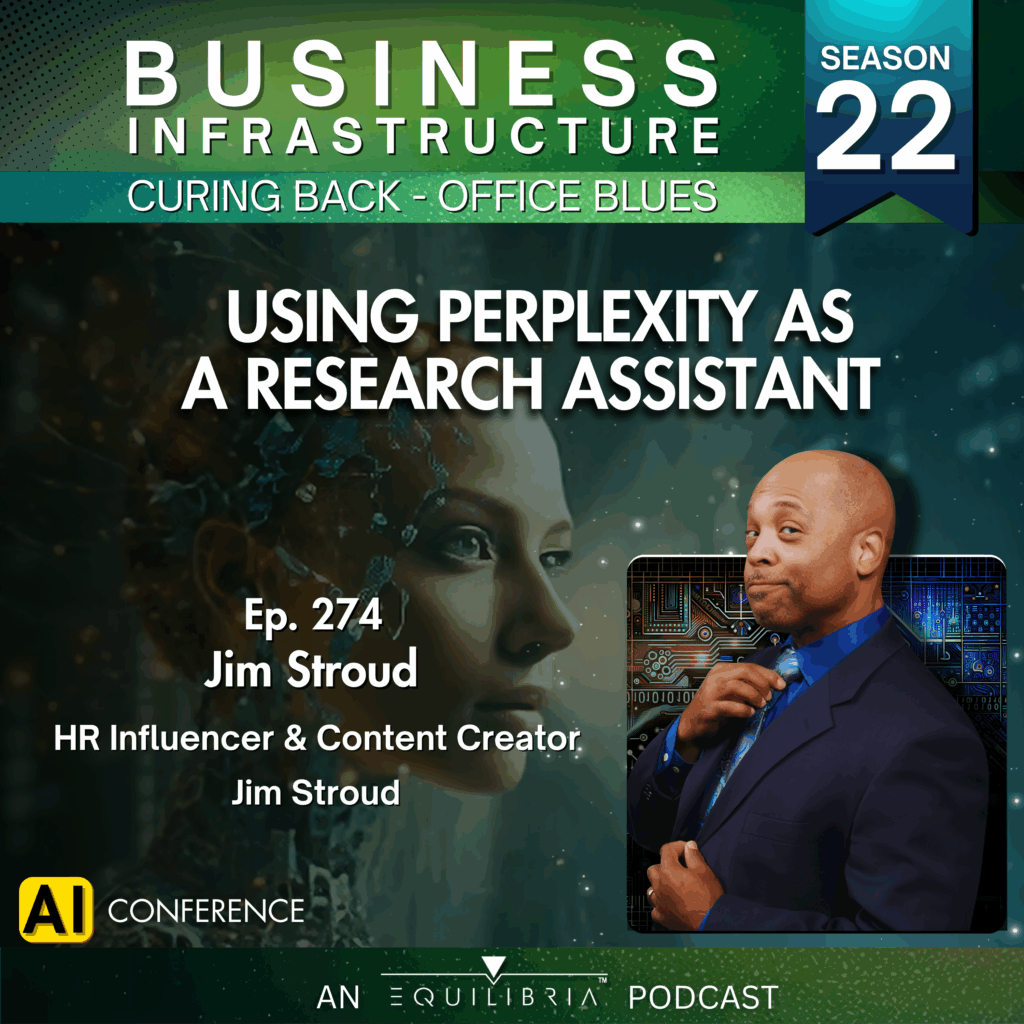Transcript
This special season features an AI audio conference, proudly sponsored by Equilibria, Incorporated. We hope you enjoy this episode!

Welcome to Season 22 of the Business Infrastructure podcast. I’m Alicia Butler Pierre and on this show, we share operational tips, strategies, and tactics to help you cure any back-office blues you might be experiencing.
In the last episode, we kicked off the audio portion of our AI conference with a fireside chat. Now, we’re going to hear from another speaker who will share a practical application of AI, something that you can use to streamline your operations.
During this speaker’s presentation, I’ll provide live commentary so that you can follow along with what’s going in the room. So, from time to time I’ll interject and, like a reporter, I’ll be sure to ask questions along the way since you won’t have the benefit of being here in person. Before we start, here’s a quick disclaimer – the nature of AI technology is changing fast, so it’s possible some of the information in this episode might be dated since the original presentation. But, I encourage to learn what you can, test it, and most importantly have fun…Now let’s get to it…
This is Ep. 274: Using Perplexity as a Research Assistant with Jim Stroud
Welcome to the Perplexity presentation. Perplexity is your productivity tool that you will love. Use it once and you’ll use it forever, guaranteed. My name is Jim Stroud, and I’m the founder of JimStroud.com, and I’m going to show you how to use Perplexity to make your business life a little bit easier. Let’s give it a try.

Ooh, I can already tell this is going to be a lively and informative presentation! I’m especially excited about his presentation because Jim is one of my good friends as well as one of my trusted advisors. I’m sitting in the middle of the room where’s he’s presenting. He’s standing at the front on a raised platform with a large screen behind him. As I look around me, there are about 300 people in the room, which, honestly doesn’t surprise me. Jim’s a rockstar and one heck of a presenter! He started by sharing his deep expertise in the recruiting field of H.R. and how that led to his interest in AI.
20 years of experience in recruitment and sourcing. Consulted such companies as Microsoft, Google, Siemens and a host of startup companies. During my tenure with Randstat Sourceright, I alleviated the sourcing and recruiting headaches of Randstat clients worldwide as its global head of sourcing and recruiting strategy. Quite recently, I served as VP of Marketing for Proactive Talent, the most recognized and respected name in talent attraction, hiring and retention. Presently I produced The Recruiting Life,
which is a newsletter and comic strip about the world of work.

While generating demand for HR tech companies with awesome content, I became enamored with AI with the appearance of Chat GPT. I had heard about it through buzz. A lot of people were talking about, Have you seen this? This is amazing! And I had already been aware of artificial intelligence from previous projects, and I figured Chat GPT was just more of the same. But I was so surprised when I saw how it operated and became sort of enamored with it. So, I started doing product demos of it. I posted some on YouTube. And I just became somewhat of a Chat GPT enthusiast. So, producing videos around it, doing some training around it for some clients, also written articles about it and just loved it and still do.
Jim then went on to explain how although he likes Chat GPT, once he discovered Perplexity, a generative AI tool, it has taken his research efforts to another level.
Perplexity was created by people who were formerly working for OpenAI, the company behind Chat GPT. They had some ideas of the direction Chat GPT should go in, so they decided to break off and start their own version, which is Perplexity. It’s his own large language model, but it has additional bells and whistles that I appreciate. Although Chat GPT is part of its functionality, it does have added bells and whistles that Chat GPT does not have. For the most part, the wow factor of it, I feel, is that when you are
searching for Chat GPT, you type in your answers, you type in your questions, your queries, your prompts, and then Chat GPT gives you an answer.
Similarly, with Perplexity, you type in your prompt, and it gives you an answer. But it tells you where the information is coming from, which I greatly appreciate, because there are times when Chat GPT will just make something up, and it will sound so believable. And unless you do your due diligence to sort of double check it, you don’t really know that you’re reading a hallucination, so to speak. That’s the technical term for it. But with Perplexity, it gives you an answer and it tells you where the answer came from.
So, I love that. It gives you typically information from five sources, and if you are curious about more, it gives you the option to run the same query with additional sources so you can save even more time. So, I use it a lot when I’m researching articles that I am producing. I use it when I’m doing a little due diligence on a podcast guest or if I’m producing a video or some other type of content. I use Perplexity pretty much every day for that one functionality. Now, there’s more to it than what I would show, but for the sake of time, I would like to show you sort of one aspect of how we use it, which is articles.
As Jim prepared to start giving a demo of Perplexity, I raised my hand to ask him if Perplexity is free and, if so, what’s the difference between the free version versus the paid version?
It’s a free service, but it does have a premium option as well. They also have some things that they integrate into it from Chat GPT like Copilot. And with Copilot, you’re able to put yourself in context so you can say, “Okay, I am a scientific research scientist and I’m working on the cure for cancer. That’s my background.” So, by putting that information into Perplexity, when you’re asking it different questions or giving it different prompts in the future, it will take it in the context of you being a research scientist,
right? So, you can say, “What are the cool kids into this year?” And it will answer that based on you being a research scientist. It will tell you what the latest trends are in science as relation to cancer research or oncology. And that’s really helpful because that’ll help you your research even more so.
I had another question for Jim. Yes, I know I’m jumping ahead, but I couldn’t wait. I had to know, how has Perplexity increased Jim’s productivity and efficiency?

The amount of time I save in research with Perplexity, it’s night and day. It’s night and day. I produce a lot of content for my clients, right? So, if I am writing an article, my articles tend to be very research focused, so I probably save 4 hours of research time with Perplexity that I just love. I just can’t put it down. So, I literally use it every day just for that. The time saving alone is worth the $20, I think it is a month. But the free version gives me everything that I need. So, I haven’t had the need to really go
premium, although I’m still sort of thinking about it. Maybe if I buy the premium version, I’ll save 6 hours, but right now I’m saving a lot of time.
Jim then walked over to the podium. He lifted the lid of the laptop that sat on top of it to go online. As he opened Perplexity’s website, he went into more detail about his boost in productivity, but from the people aspect of business infrastructure. He wanted to make sure he addressed the very real concern of potentially eliminating the need for a human research assistant.
I would never want to give full responsibility to any machine or tool to do anything because machines have glitches, and they make mistakes just like human beings do. The advantage of the machines is that they’re able to make the mistakes a lot faster, if you want to call it that. They’re able to do a lot of tasks quicker. But there should always be a human being in the loop. Case in point what we said earlier about Chat GPT. It was amazing the information I received, but some of it was a hallucination, which is the term that people in the scientific community use.
They say it’s hallucination when it makes answers up. So, if you didn’t have a human being going over the information and saying that doesn’t sound right, then they do further research and they’re able to see that in fact, it was a hallucination. So, there should always be a human being involved in the process. You never want to be so into technology that you lose your own human perspective.
I’ll give you an example of that. There have been news stories which are easy to find, where people have driven into rivers because they were listening to the GPS so intently and not thinking for themselves that they literally drove into the water.
I’ve also read recently where these robot cars, robot taxis, have caused more traffic jams. One of the selling points of these automated cars, robot taxis is that it will be an easier way to get around. There will be less traffic, less accidents, because the machines are doing everything. But there have been new stories coming out showing that they have been responsible for making traffic worse. Got to always have a human being in the loop. It’s easy to take technology as sort of panacea that’ll just cure everything, but it’s just not the case.
Jim typed Perplexity.AI in the search bar of Google Chrome. On the large screen, those of us in the audience saw, well, not very much. The home page of this site is very basic, not much on it – there’s a navigation menu on the left-hand side, but most of the page is dedicated to a large box with a simple prompt that says, “Ask anything…” This is the area where Jim placed the cursor to begin typing.
I just saw this book that I’m going to pick up and read. It was a very interesting title. It was called BS Job Theory. Right? So, I see that title, I’m thinking, What is that? So, I’ll type in “What is BS Job Theory?” And up here, to top, it shows you the different places online where it has been talked about and where it pulled this information from. Down here, it gives an explanation of the theory by David Graeber, which is an actual theory. And then it tells you down here we’re related additional questions that you can ask that are in relation to what you did.

So, you may, uh, what are some examples of BS jobs?
Maybe I should have chosen a different example. Apologies, but I just realized that. So, it gives me answers to that question. And again, it lets me know where I got the information from, and it gives me additional related questions. And then down here, I can click view sources. And if I want to add more sources to review, click more sources and there’s even more information that I can pull from.
As Jim just described, his query of “What is BS Jobs Theory” yielded an answer with links to sources of that answer directly above and links to related questions to that answer directly below. There are other icons near the answer itself that you can click to do things like share the answer, request that Perplexity rewrite the answer, and even report the answer as inaccurate. Someone in the audience asked Jim how he would use that
answer he has on the screen to write an article.
When I’m writing an article, I’ll start off with one question, get my information, and then I’ll look at the related questions. And sometimes it’ll take me to a different direction that I hadn’t normally thought of. And I’ll say, “Oh, I haven’t thought about that before. Let me click that,” and that’ll give me more information, which will in turn give me more related articles to consider. And I’ll say, “Oh, I haven’t thought about that.” And before you know it, I have a basic outline for an article that I could start writing
or research even further.
It sounded like Jim just described his research and writing process. Naturally, this intrigued me so I raised my hand to ask if he could share a little bit more about his process. After all, processes are another element of business infrastructure.
So, I have the idea. I typed a question. Usually when it gives me the initial answer, it’s usually two or three paragraphs. And sometimes that’s enough for me to start writing there, right? But then there’ll be something mentioned in the three-paragraph answer that I think, Ah, I want to know more about this, that and the other. And so, I start going down the rabbit hole. I usually go down four or five levels. And then from those different answers, I piece together an article. That way I’ve written articles that are 2000, 5000 words long using this process. Again, just finding all the different sources and getting a basic outline.
So, another way to look at this is instead of doing a Google search, you get your results and then you look at each result to see if it’s something that you can use. What Perplexity is doing is basically taking five different sources right off the top and it is summarizing information from those five different sources and putting it into three paragraphs, a basic outline. So essentially what it’s done is read these articles, pull relevant information into three paragraphs. I then read these three paragraphs and think, Okay, essentially this is what’s going on among these different sources. This could be a basic outline here, but wait, I see something that interests me, so let me research that further. Or I look at the different related questions, which has even more information there. And I think, Okay, let me go down that rabbit hole. So that’s essentially how I do it.

Someone else in the audience stood up to signal that the presentation assistant holding the microphone go over to her so that Jim could hear her question. She introduced herself as an educator and expressed concern about her students plagiarizing content as a result of using tools like Chat GPT and Perplexity.
Well, some schools have gone to the point of banning Chat GPT from the school. Some have reimplemented pencil and paper for that. But on the other side there are some schools that have said, “Embrace Chat GPT. But let me see your thought processes. Why did you ask it this? Why did you ask it that? What information here prompted you to go into that direction?” Because they want to see if you are thinking critically. So, I can see arguments from both sides of the scale. Cutting and pasting from Chat GPT, from a content production standpoint, I would caution against because there are tools out there that show that it’s generated by AI and that might sort of hurt your credibility.
Now, I have noticed that with Chat GPT, there is a way to train it to write in your voice. I don’t know if I want to put that out in the wild. I don’t think the masses have caught on to that, but it is possible to do that. So, then the argument comes, well, if Chat GPT can write in your voice, is it really plagiarizing? Then it’s chicken and egg kind of thing.
Jim realized he needed to wrap up the demo portion of his presentation. He said he could answer one more question. A tall guy in the back of the room raised his hand. Once he received the microphone, he asked if it’s possible to feed information directly into Perplexity and ask it to produce a summary based on that information. Jim offered to test this live by copying the URL from another article he’d seen and pasting it into the
search field in Perplexity.
Let’s look at this. Let’s look at what it said. Said “The link provided in the question cannot be accessed by Perplexity.” However, based on the available search results, the article with the given DOI is titled…the article debunks for it…Okay, so what is done is it wasn’t able to summarize the article for whatever reason, but it did find other articles online that talked about the article that we had an interest in. And it said, based on the articles that have cited the article that we originally were interested in. This is what it
says, which is amazing that it did all of that in like two seconds. That’s really impressive and scary at the same time.
I agree. It is impressive and…scary. On one hand there’s the speed and quick links to other related information and sometimes images. On the other hand, there’s the likelihood for inaccurate information. What are the chances that the average Perplexity user will drill down several layers in their research let alone check the validity of all the produced answers or responses?
You can probably tell where I’m going with all of this, right? Now Jim managed to talk about Perplexity and how it can strengthen your own company’s business infrastructure – that is, the people, processes, and tools itself. As he closed the laptop’s lid, he stepped away from the podium to offer some closing words of advice as one more person managed to slide in another question about addressing fear of using AI tools like Perplexity.
There’s a risk of sounding too blunt – get over it! Because the point that we’re in right now is the same point we were in, say, in the early 80s when the Internet was just starting to catch on, when America Online had diskettes all over the place and people are like, This Internet, what is this? I don’t get it. It’s too much. I’m just not going to deal with it. Now, the internet is a way of life. It’s hard to imagine any business that does not have an Internet presence. To some degree, AI is in the same inflection point now, where there’s so much that can be done with it and it can be overwhelming because it changes literally every single day, no lie.

But to have a basic understanding of what it can do is to your business advantage. I think that because AI can do so many different things because there are so many different tools built on top of Chat GPT and other tools like it. And you have other competitors coming out like Bard from Google. Amazon is making its own Chat GPT competitor. Apple is building its own Chat GPT competitor. This stuff is not going away. It’s really great that it can do so much with so little. If you can master it or if you get a good understanding of it, it puts you on a more competitive level because maybe you can’t afford to hire ten or twelve writers to help run your media company. But you understand how to use Chat GPT, you understand how to use Perplexity, you understand how to use other tools like it. Now you’re able to create a bunch of content rather quickly.
And now you don’t have to pay as many people to do the work that you would have done before. And by the time you do get to a point where you can afford more people, you can boost your productivity even more. Because you understand these tools, you train them how to do these tools. And now instead of maybe four articles a day, you’re doing 40 articles a day. You know? So, I think embracing it will make you more competitive on the world stage. And I think if you ignore it and say it’s too much, I’m not going to do anything, it’s to your detriment. AI may not put you out of business per se, but someone who does know how to use it may be the one who puts you out of business on down the road. So, it’s really a matter of survival at this point.
Amen, Jim! If that wasn’t a dose of reality, then I don’t know what is! I noticed he looked down at the timer in front of him on the stage. Time is running out but he made sure to reiterate the benefits of Perplexity as well as letting us know how we can get it touch with him.
Go to Perplexity AI. One of the reasons why I like this tool so much is because I did not need a manual per se. It operated pretty much like a Google search. Just type in a question. I didn’t even have to know a lot of fancy prompt formats. I just treated it like it was a Google search box and acted accordingly. And that’s pretty much how they have it set up. So if you can do Google, you can do Perplexity.
As far as my work, you can find it on my website at JimStroud.com, JimStroud.com. There you will see a lot of my content. You can go to Youtube.com, JimStroud, and you’ll see a lot of videos. Among those videos you’ll see a playlist called a Chat GPT playlist and you’ll see different videos there. I think about eight or ten of them, I’ve done on Chat GPT on that playlist. Now, they tend to be towards training recruiters how to use Chat GPT to make their recruiting lives a bit easier. But the same principles apply to
business owners. Just change the keywords out or change the questions slightly and you’ll still be able to use it to that advantage. And finally, also on JimStroud.com is a link to my newsletter, The Recruiting Life. Subscribe now, subscribe often.
Thank you for listening! If you enjoyed this episode, then please subscribe and give us a five-star rating and review. You can watch the video version of this interview, as well as access links to the resources Jim mentioned, at BusinessInfrastructure.TV. That’s BusinessInfrastructure.TV.

We hope you enjoyed this session of our AI audio conference and learned some things to improve your company’s back-office operations. Our next speaker will also give an AI product demo.
Be sure to come back to the place wherever you’re listening to this episode, so that you don’t miss that demo! Until then, remember to stay focused and be encouraged. This entrepreneurial journey is a marathon and not a sprint.
We hope you enjoyed this session of our AI audio conference and learned some things to improve your company’s back-office operations. Our next speaker will also give an AI product demo.
Alicia Butler Pierre hosted and produced this episode. Voiceovers by Kenya A. Moses and Nhea Durousseau. Audio editing by Olanrewaju Adeyemo. Original score and sound design by Sabor! Music Enterprises. Video editing by Gladiola Films. A special thank you to Erika Ve Revilla for creating the show notes and to Monique Inge, our guest relationship manager
This is the Business Infrastructure – Curing Back-Office Blues podcast.
















